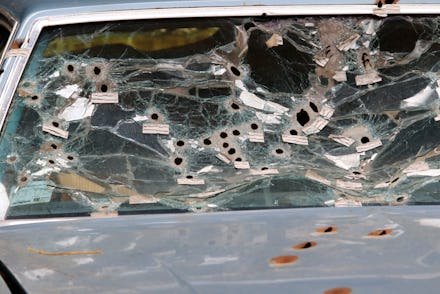American Police Fire More Shots in 1 Day Than Some Countries Do in 1 Year

In May, Cleveland police officer Michael Brelo was cleared of any wrongdoing in the 2012 deaths of two unarmed black motorists. Brelo had climbed onto the hood of the victims' Chevrolet Malibu and fired 15 shots into the windshield after he and 12 other officers mistook the car backfiring for gunshots and opened fire, bringing the total number of bullets fired during the incident to 137.
In comparison, the Norwegian police force fired only two shots in the entirety of 2014, according to statistics recently released by Norway's government. Neither shot killed or injured anyone.
The government report, Police Threat or Use of Firearms 2002-2014, brings the willingness of American police officers to use deadly force against suspects — armed or otherwise — into stark relief with that of officers in other developed nations.
In the same year that Brelo fired nearly three magazines' worth of bullets during a single incident and U.S. law enforcement shot 409 people to death in "justifiable homicides," police in England and Wales fired a weapon just once. No one died. The following year, Icelandic police committed its first fatal shooting in the nation's modern history. The police force later apologized to the man's family.
Although the U.S. government doesn't maintain statistics about the number of people killed in altercations with police, much less the number of shots fired by American police officers, data compiled by the Washington Post shows that at least 487 people have been killed in police shootings so far this year.
The gap isn't completely accounted for by population differences. Although the U.S., with a population more than 62 times that of Norway and nearly 1,000 times that of Iceland, has more police officers than some nations have citizens, incidents of police shootings on a per capita basis still make American police the deadliest in the developed world.
In Germany, for example, a country with a population of roughly 82 million people, there were only eight fatal shootings by police between 2011 and 2013, equating to roughly one gun death by law enforcement per 10,250,000 citizens. In Canada — the northern neighbor of the United States with its own long and rich history of firearm possession — police average roughly 25 fatal shootings every year. In California, which has a population only 10% smaller than Canada's, police shot and killed nearly three times as many people in just the first five months of 2015.
Even when adjusting for the smaller size of Britain's population, the Economist found that a British resident is 100 times less likely to be shot by police than an American one: "Between 2010 and 2014 the police force of one small American city, Albuquerque in New Mexico, shot and killed 23 civilians; seven times more than the number of Brits killed by all of England and Wales's forces during the same period."
The reason for such low shooting rates? Fewer guns. Most Norwegian, British and Icelandic police don't routinely carry firearms on their person (although all are trained in their use and many keep them in their vehicles), decreasing exponentially the chance of their use against civilians. In the U.S., by comparison, the militarization of police has armed American law enforcement to the teeth.
The high rate of civilian gun ownership in the U.S. may be the root of this militarization. According to the Coalition to Stop Gun Violence, the militarization of police is the product of a "continuing arms race between civilians and law enforcement." Lax laws over the sale and ownership of increasingly sophisticated firearms by civilians are forcing American law enforcement to beef up its own arsenal as a way of keeping up with the population it polices, the organization notes:
The overwhelming majority of law enforcement officers are good men and women who are legitimately concerned about the type of firepower they are now being confronted with on America's streets. This arms race is making our neighborhoods more dangerous and benefitting only one party: the gun industry, which sees continuing escalation as a business opportunity.
High rates of gun ownership of the civilian population can't fully explain the chasm between law enforcement shooting rates in the U.S. and other developed nations, however. In Iceland, where roughly 1 in 3 citizens owns a gun (making the island nation the 15th most-privately armed country in the world per capita), the nation's sole gun death by law enforcement spurred weeks of nationwide grief.
In the end, the way to best curb the rate of police shootings in the U.S. may be to limit civilian access to the kinds of military-grade weaponry fueling the arms race in an act of mutual disarmament. Given America's increasingly lax gun laws, however, that disarmament is a remote possibility.
In the meantime, police officers in the U.S. have shot, on average, three and a half people per day in the month of July.